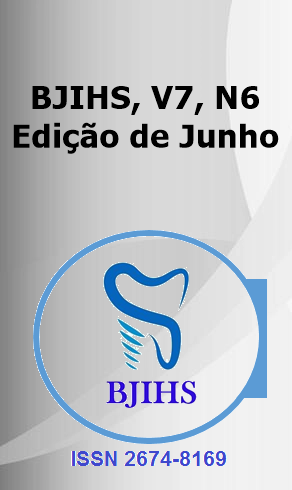Abstract
Introduction: Hypoxic-ischemic encephalopathy (HIE) affects around 1.5 per 1,000 live births and is one of the main causes of neonatal mortality and neurological impairment. Therapeutic hypothermia (TH), started in the first six hours of life, has been shown to significantly reduce mortality and disabilities at 18 months and is recommended internationally in moderate to severe cases. Systemic cooling between 33°C and 34°C for 72 hours is the most widely used protocol, although its effectiveness in premature infants is still unclear. Clinical assessment, especially using the modified Sarnat score, and team training are essential for successful treatment and for promoting neuropsychomotor development (NPMD), a multifactorial process influenced by genetic, environmental and family factors. In view of this, this study aims to review the efficacy and safety of hypothermia in the treatment of HIE in neonates and its impact on neuropsychomotor development. Methodology: This study carried out an integrative literature review, between February and March 2025, on the SciELO, PubMed and VHL databases, using specific descriptors. Of the 384 articles found, 10 made up the final sample, respecting inclusion criteria such as language, year of publication and type of study. Articles prior to 2017, observational studies and narrative reviews were excluded. Results and discussion: The results showed that the effectiveness of HT depends on individualized assessment. Although studies indicate risks in stopping treatment before 72 hours, its efficacy in mild IHE remains controversial. The lack of standardization between centers contributes to variations in outcomes. HT has been shown to be effective in reducing seizures, hospital costs and inflammatory markers. Continuing education programs and the use of telemedicine have contributed to better clinical practices. Conclusion: HT is effective in moderate to severe IHE, but its use in mild cases or in premature infants lacks evidence. Standardization of protocols, monitoring and more research are needed to ensure safety, effectiveness and a positive impact on health policies
References
BONIFACIO, S. L.; HUTSON, S. The term newborn: evaluation for hypoxic-ischemic encephalopathy. Clinics in perinatology, v. 48, n. 3, p. 681-695, 2021.
HAGMANN, C. F. et al. Hypothermia for perinatal asphyxial encephalopathy. A Swiss survey of opinion, practice and cerebral investigations. Swiss medical weekly, v. 141, p. w13145, 2011.
KURT, A.; ZENCIROĞLU, A.; AKDUMAN, H. The impact of therapeutic hypothermia on peripheral blood cell in newborns with hypoxic ischemic encephalopathy. Brazilian Journal of Pharmaceutical Sciences, v. 58, p. e181053, 2022.
LALLY, P. J. et al. Residual brain injury after early discontinuation of cooling therapy in mild neonatal encephalopathy. Archives of Disease in Childhood-Fetal and Neonatal Edition, v. 103, n. 4, p. F383-F387, 2018.
LAPTOOK, A. R. et al. Effect of therapeutic hypothermia initiated after 6 hours of age on death or disability among newborns with hypoxic-ischemic encephalopathy: a randomized clinical trial. Jama, v. 318, n. 16, p. 1550-1560, 2017.
LEANDRO, D. M. K. et al. Therapeutic Hypothermia for Neonatal Hypoxic–Ischemic Encephalopathy: Reducing Variability in Practice through a Collaborative Telemedicine Initiative. American Journal of Perinatology, v. 41, n. 16, p. 2263-2270, 2024.
LIU, Fudong; MCCULLOUGH, Louise D. Inflammatory responses in hypoxic ischemic encephalopathy. Acta Pharmacologica Sinica, v. 34, n. 9, p. 1121-1130, 2013.
MONTALDO, P. et al. Therapeutic hypothermia initiated within 6 hours of birth is associated with reduced brain injury on MR biomarkers in mild hypoxic-ischaemic encephalopathy: a non-randomised cohort study. Archives of Disease in Childhood-Fetal and Neonatal Edition, v. 104, n. 5, p. F515-F520, 2019.
OLIVEIRA, V. et al. Therapeutic hypothermia in mild neonatal encephalopathy: a national survey of practice in the UK. Archives of Disease in Childhood-Fetal and Neonatal Edition, v. 103, n. 4, p. F388-F390, 2018.
RIVERO-ARIAS, O. et al. Hypothermia for perinatal asphyxia: trial-based resource use and costs at 6–7 years. Archives of Disease in Childhood-Fetal and Neonatal Edition, v. 104, n. 3, p. F285-F292, 2019.
ROCA-LLABRÉS, P. et al. Therapeutic hypothermia in preterm infants under 36 weeks: Case series on outcomes and brain MRI findings. European Journal of Pediatrics, v. 184, n. 1, p. 113, 2025.
SILVA, A. M. da et al. Neuropsychomotor development, socioeconomic and neonatal factors in children aged 18-36 months attending daycare. Cadernos de Pós-Graduação em Distúrbios do Desenvolvimento, v. 21, n. 2, p. 39-57, 2021.

This work is licensed under a Creative Commons Attribution 4.0 International License.
Copyright (c) 2025 Yasmim Karolaine Gomes Delgado , Tarcísio Pereira Vasconcelos Neto, Roberta Marques da Silva, Talita Maria Araújo de Abreu, Larissa Thaís Ferreira de Luna Gomes Delfino, Maria Rayane de Paiva Rodrigues, Raquel alves da Costa, Lizandra Cecília Andrade Pereira, Amanda Valeska do Nascimento Duarte Mendonça, Ana Beatriz Sampaio Casé, Matheus William Medeiros da Paz, Wliana Lara Moreira Menezes

